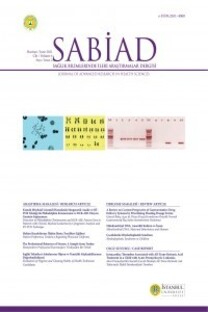miR-3653-3P EXPRESSION IN PERIPHERAL BLOOD OF PATIENTS WITH OVARIAN CARCINOMA
Ovarian cancer is a late-stage cancer with early and frequent recurrence, and there is still no effective treatment.There are no sensitive and specific biomarkers to be used effectively in the early diagnosis and treatment of the disease.Those currently used in the clinic are extremely insufficient for the early diagnosis and treatment follow-up of the disease, in terms of accurately determining the minimal residual disease.Many studies have shown that deregulation or dysfunction of miRNAs in the small non-coding RNA class contributes to cancer development However, it is known that the expressions of a number of miRNAs differ in ovarian cancer. Examining the expression patterns of known miRNAs in cancer research by comparing them between patients and healthy people is extremely important in terms of finding disease-specific biological markers, and determining the roles of these molecules in the pathogenesis of ovarian cancer is also significant.In the thesis study presented, the expression profile of miR-3653-3p was investigated in a control group consisting of 150 high-risk ovarian cancer patients and 100 healthy individuals, and both groups were compared with each other.It was found that the expression level of miR-3653-3p in the peripheral blood of ovarian cancer patients was 9.49 times higher than the control groups and the results were shown to be statistically significant(p = 0.00).In addition to these results, whether miR-3653-3p can be used as a non-invasive biomarker in peripheral blood for ovarian cancer was evaluated by ROC analysis and it was shown that the molecule in question was a statistically significant biomarker.
miR-3653-3P EXPRESSION IN PERIPHERAL BLOOD OF PATIENTS WITH OVARIAN CARCINOMA
Ovarian cancer is a late-stage cancer with early and frequent recurrence, and there is still no effective treatment.There are no sensitive and specific biomarkers to be used effectively in the early diagnosis and treatment of the disease.Those currently used in the clinic are extremely insufficient for the early diagnosis and treatment follow-up of the disease, in terms of accurately determining the minimal residual disease.Many studies have shown that deregulation or dysfunction of miRNAs in the small non-coding RNA class contributes to cancer development However, it is known that the expressions of a number of miRNAs differ in ovarian cancer. Examining the expression patterns of known miRNAs in cancer research by comparing them between patients and healthy people is extremely important in terms of finding disease-specific biological markers, and determining the roles of these molecules in the pathogenesis of ovarian cancer is also significant.In the thesis study presented, the expression profile of miR-3653-3p was investigated in a control group consisting of 150 high-risk ovarian cancer patients and 100 healthy individuals, and both groups were compared with each other.It was found that the expression level of miR-3653-3p in the peripheral blood of ovarian cancer patients was 9.49 times higher than the control groups and the results were shown to be statistically significant(p = 0.00).In addition to these results, whether miR-3653-3p can be used as a non-invasive biomarker in peripheral blood for ovarian cancer was evaluated by ROC analysis and it was shown that the molecule in question was a statistically significant biomarker.
___
- Grozescu T, Popa F. Prostate cancer between prognosis and adequate/proper therapy. J Med Life. 2017;10(1):5-12
